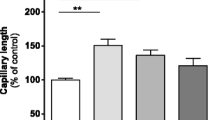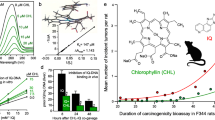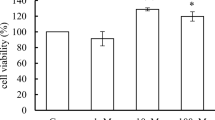Abstract
In situ chemical reduction (ISCR) has been identified as a possible way for the remediation of soils contaminated by chlordecone (CLD). Evidences provided by the literature indicate an association between the development of prostate cancer and CLD exposure (Multigner et al. 2010). In a previous in vitro study, we demonstrated that the two main dechlorinated CLD derivatives formed by ISCR, CLD-1Cl, and CLD-3Cl have lower cytotoxicity and proangiogenic properties than CLD itself (Legeay et al. 2017). By contrast, nothing is known on the in vivo proangiogenic effect of these dechlorinated derivatives. Based on in vitro data, the aims of this study were therefore to evaluate the in vivo influence of CLD and three of its dechlorinated metabolites in the control of neovascularization in a mice model of prostate cancer. The proangiogenic effect of CLD and three of its dechlorinated derivatives, CLD-1Cl, CLD-3Cl, and CLD-4Cl, was evaluated on a murine model of human prostate tumor (PC-3) treated, at two exposure levels: 33 μg/kg and 1.7 μg/kg respectively reflecting acute and chronic toxic exposure in human. The results of serum measurements show that, for the same ingested dose, the three metabolite concentrations were significantly lower than that of CLD. Dechlorination of CLD lead therefore to molecules that are biologically absorbed or metabolized, or both, faster than the parent molecule. Prostate tumor growth was lower in the groups treated by the three metabolites compared to the one treated by CLD. The vascularization measured on the tumor sections was inversely proportional to the rate of dechlorination, the treatment with CLD-4Cl showing no difference with control animals treated with only the vehicle oil used for all substances tested. We can therefore conclude that the proangiogenic effect of CLD is significantly decreased following the ISCR-resulting dechlorination. Further investigations are needed to elucidate the molecular mechanisms by which dechlorination of CLD reduces proangiogenic effects in prostate tumor.





Similar content being viewed by others
References
Adir J, Caplan YH, Thompson BC (1978) Kepone serum half-life in humans. Life Sci 22:699–702
Alabed Alibrahim E, Andriantsitohaina R, Hardonnière K, Soleti R, Faure S, Simard G (2018) A redox-sensitive signaling pathway mediates pro-angiogenic effect of chlordecone via estrogen receptor activation. Int J Biochem Cell Biol 97:83–97. https://doi.org/10.1016/j.biocel.2018.02.008
Belghit H, Colas C, Bristeau S, Mouvet C, Maunit B (2015) Liquid chromatography–high-resolution mass spectrometry for identifying aqueous chlordecone hydrate dechlorinated transformation products formed by reaction with zero-valent iron. Int J Environ Anal Chem 95:93–105. https://doi.org/10.1080/03067319.2014.994615
Bichon E, Guiffard I, Vénisseau A, Marchand P, Antignac JP, le Bizec B (2015) Ultra-trace quantification method for chlordecone in human fluids and tissues. J Chromatogr A 1408:169–177. https://doi.org/10.1016/j.chroma.2015.07.013
Borja J, Taleon DM, Auresenia J, Gallardo S (2005) Polychlorinated biphenyls and their biodegradation. Process Biochem 40:1999–2013. https://doi.org/10.1016/j.procbio.2004.08.006
Cabidoche Y-M, Achard R, Cattan P, Clermont-Dauphin C, Massat F, Sansoulet J (2009) Long-term pollution by chlordecone of tropical volcanic soils in the French West Indies: a simple leaching model accounts for current residue. Environ Pollut Barking Essex 1987(157):1697–1705. https://doi.org/10.1016/j.envpol.2008.12.015
Center MM, Jemal A, Lortet-Tieulent J, Ward E, Ferlay J, Brawley O, Bray F (2012) International variation in prostate cancer incidence and mortality rates. Eur Urol 61:1079–1092. https://doi.org/10.1016/j.eururo.2012.02.054
Chaussonnerie S, Saaidi P-L, Ugarte E, et al (2016) Microbial degradation of a recalcitrant pesticide: chlordecone. Front Microbiol 7:2025. https://doi.org/10.3389/fmicb.2016.02025
Clere N, Lauret E, Malthiery Y, Andriantsitohaina R, Faure S (2012) Estrogen receptor alpha as a key target of organochlorines to promote angiogenesis. Angiogenesis 15:745–760. https://doi.org/10.1007/s10456-012-9288-7
Clostre F, Lesueur-Jannoyer M, Cadiboche Y-M (2010) Rémédiation à la pollution par la chlordécone aux Antilles
Cohn WJ, Boylan JJ, Blanke RV, Fariss MW, Howell JR, Guzelian PS (1978) Treatment of chlordecone (Kepone) toxicity with cholestyramine. Results of a controlled clinical trial. N Engl J Med 298:243–248. https://doi.org/10.1056/NEJM197802022980504
Dallaire R, Muckle G, Rouget F, Kadhel P, Bataille H, Guldner L, Seurin S, Chajès V, Monfort C, Boucher O, Pierre Thomé J, Jacobson SW, Multigner L, Cordier S (2012) Cognitive, visual, and motor development of 7-month-old Guadeloupean infants exposed to chlordecone. Environ Res 118:79–85. https://doi.org/10.1016/j.envres.2012.07.006
Dalu A, Mehendale HM (1996) Efficient tissue repair underlies the resiliency of postnatally developing rats to chlordecone + CCl4 hepatotoxicity. Toxicology 111:29–42
Le Déault Y, Procaccia C (2009) Rapport sur les impacts de l’utilisation de la chlordécone et des pesticides aux Antilles: bilan et perspectives d’évolution. OPECST Paris Assem Natl
Deloumeaux J, Bhakkan B, Eyraud R, Braud F, Manip M’Ebobisse N, Blanchet P, Brureau L (2017) Prostate cancer clinical presentation, incidence, mortality and survival in Guadeloupe over the period 2008-2013 from a population-based cancer registry. Cancer Causes Control CCC 28:1265–1273. https://doi.org/10.1007/s10552-017-0962-3
Diehl KH, Hull R, Morton D, Pfister R, Rabemampianina Y, Smith D, Vidal JM, van de Vorstenbosch C, European Federation of Pharmaceutical Industries Association and European Centre for the Validation of Alternative Methods (2001) A good practice guide to the administration of substances and removal of blood, including routes and volumes. J Appl Toxicol JAT 21:15–23
Dolfing J, Novak I, Archelas A, Macarie H (2012) Gibbs free energy of formation of chlordecone and potential degradation products: implications for remediation strategies and environmental fate. Environ Sci Technol 46:8131–8139. https://doi.org/10.1021/es301165p
Egle JL, Fernandez JB, Guzelian PS, Borzelleca JF (1978) Distribution and excretion of chlordecone (Kepone) in the rat. Drug Metab Dispos 6:91–95
Eske K, Newsome B, Han SG, Murphy M, Bhattacharyya D, Hennig B (2014) PCB 77 dechlorination products modulate pro-inflammatory events in vascular endothelial cells. Environ Sci Pollut Res Int 21:6354–6364. https://doi.org/10.1007/s11356-013-1591-3
Euhus DM, Hudd C, LaRegina MC, Johnson FE (1986) Tumor measurement in the nude mouse. J Surg Oncol 31:229–234
Faroon O, Kueberuwa S, Smith L, DeRosa C (1995) ATSDR evaluation of health effects of chemicals. II. Mirex and chlordecone: health effects, toxicokinetics, human exposure, and environmental fate. Toxicol Ind Health 11:1–203
Fintz M (2010) L’autorisation du chlordécone en France, 1968–1981
Fournier A, Feidt C, Lastel M-L, Archimede H, Thome JP, Mahieu M, Rychen G (2017) Toxicokinetics of chlordecone in goats: implications for risk management in French West Indies. Chemosphere 171:564–570. https://doi.org/10.1016/j.chemosphere.2016.12.054
Guzelian PS (1982) Comparative toxicology of chlordecone (Kepone) in humans and experimental animals. Annu Rev Pharmacol Toxicol 22:89–113. https://doi.org/10.1146/annurev.pa.22.040182.000513
Jesus J, Frascari D, Pozdniakova T, Danko AS (2016) Kinetics of aerobic cometabolic biodegradation of chlorinated and brominated aliphatic hydrocarbons: a review. J Hazard Mater 309:37–52. https://doi.org/10.1016/j.jhazmat.2016.01.065
Joly P-B (2010) La saga du chlordécone aux Antilles françaises. Reconstruction chronologique 1968-2008. Rapp Proj AFSSET Action 39:2008–2010
Kadhel P, Monfort C, Costet N, Rouget F, Thomé JP, Multigner L, Cordier S (2014) Chlordecone exposure, length of gestation, and risk of preterm birth. Am J Epidemiol 179:536–544. https://doi.org/10.1093/aje/kwt313
Kim S-C, Yang JE, Ok YS, Skousen J, Kim DG, Joo JH (2010) Accelerated metolachlor degradation in soil by zerovalent iron and compost amendments. Bull Environ Contam Toxicol 84:459–464. https://doi.org/10.1007/s00128-010-9963-6
Lastel M-L, Lerch S, Fournier A, Jurjanz S, Mahieu M, Archimède H, Feidt C, Rychen G (2016) Chlordecone disappearance in tissues of growing goats after a one month decontamination period-effect of body fatness on chlordecone retention. Environ Sci Pollut Res Int 23:3176–3183. https://doi.org/10.1007/s11356-015-5833-4
Legeay S, Billat P-A, Clere N, Nesslany F, Bristeau S, Faure S, Mouvet C (2017) Two dechlorinated chlordecone derivatives formed by in situ chemical reduction are devoid of genotoxicity and mutagenicity and have lower proangiogenic properties compared to the parent compound. Environ Sci Pollut Res Int 25:14313–14323. https://doi.org/10.1007/s11356-017-8592-6
Mehendale HM (1981) Chlordecone-induced hepatic dysfunction. J Toxicol Environ Health 8:743–755. https://doi.org/10.1080/15287398109530110
Mouvet C, Collet B, Gaude J, et al (2016a) Décontamination par In Situ Chemical Reduction d’un nitisol et d’un sol alluvionnaire pollués par la chlordécone. Résultats physico-chimiques et agronomiques. Rapport final. BRGM/RP-65462-FR, 188 p., 61 ill., 61 tabl., 1 ann. http://infoterre.brgm.fr/rapports/RP-65462-FR.pdf. Access August 29th 2018
Mouvet C, Crouzet C, Bristeau S, et al (2016b) Sorption et désorption de la chlordécone et de deux de ses produits de dégradation formés par déchloration réductive. Rapport final. BRGM/RP-65357-FR, 34 p., 6 fig., 10 tabl. http://infoterre.brgm.fr/rapports/RP-65357-FR.pdf. Accesse August 29th 2018
Multigner L, Ndong JR, Giusti A, Romana M, Delacroix-Maillard H, Cordier S, Jégou B, Thome JP, Blanchet P (2010) Chlordecone exposure and risk of prostate cancer. J Clin Oncol Off J Am Soc Clin Oncol 28:3457–3462. https://doi.org/10.1200/JCO.2009.27.2153
Multigner L, Kadhel P, Rouget F, Blanchet P, Cordier S (2016) Chlordecone exposure and adverse effects in French West Indies populations. Environ Sci Pollut Res Int 23:3–8. https://doi.org/10.1007/s11356-015-4621-5
Murali B, Korrapati MC, Warbritton A, Latendresse JR, Mehendale HM (2004) Tolerance of aged Fischer 344 rats against chlordecone-amplified carbon tetrachloride toxicity. Mech Ageing Dev 125:421–435. https://doi.org/10.1016/j.mad.2004.03.005
Phillips TM, Lee H, Trevors JT, Seech AG (2004) Mineralization of hexachlorocyclohexane in soil during solid-phase bioremediation. J Ind Microbiol Biotechnol 31:216–222. https://doi.org/10.1007/s10295-004-0139-4
Phillips TM, Seech AG, Lee H, Trevors JT (2005) Biodegradation of hexachlorocyclohexane (HCH) by microorganisms. Biodegradation 16:363–392
Phillips TM, Lee H, Trevors JT, Seech AG (2006) Full-scale in situ bioremediation of hexachlorocyclohexane-contaminated soil. J Chem Technol Biotechnol 81:289–298. https://doi.org/10.1002/jctb.1390
PNAC 2008-2010 Plan d’action chlordécone en Martinique et en Guadeloupe: rapport interministériel d’activité (année 2009). http://agriculture.gouv.fr/telecharger/63798?token=aa65f5b7b786198cd89d253f56c23541.pdf.. Access August 29th 2018
PNAC 2014-2020 Plan d’action contre la pollution par la chlordécone en Guadeloupe et en Martinique 2014–2020. http://solidarites-sante.gouv.fr/IMG/pdf/plan_chlordecone_iii_11032015.pdf. Access August 29th 2018
POPRC (2007) Draft risk management evaluation: chlordecone. Geneva, Switzerland
Reuber MD (1979) The carcinogenicity Kepone. J Environ Pathol Toxicol 2:671–686
Rochelle LG, Curtis LR (1994) Distribution of chlordecone to liver plasma membranes and recovery from hepatobiliary dysfunction in rats. Toxicology 86:123–134
Sirica AE, Wilkerson CS, Wu LL, Fitzgerald R, Blanke RV, Guzelian PS (1989) Evaluation of chlordecone in a two-stage model of hepatocarcinogenesis: a significant sex difference in the hepatocellular carcinoma incidence. Carcinogenesis 10:1047–1054
Tuck MK, Chan DW, Chia D, Godwin AK, Grizzle WE, Krueger KE, Rom W, Sanda M, Sorbara L, Stass S, Wang W, Brenner DE (2009) Standard operating procedures for serum and plasma collection: early detection research network consensus statement standard operating procedure integration working group. J Proteome Res 8:113–117. https://doi.org/10.1021/pr800545q
Venkatachalam K, Arzuaga X, Chopra N, Gavalas VG, Xu J, Bhattacharyya D, Hennig B, Bachas LG (2008) Reductive dechlorination of 3,3′,4,4′-tetrachlorobiphenyl (PCB77) using palladium or palladium/iron nanoparticles and assessment of the reduction in toxic potency in vascular endothelial cells. J Hazard Mater 159:483–491. https://doi.org/10.1016/j.jhazmat.2008.02.109
Wiegel J, Wu Q (2000) Microbial reductive dehalogenation of polychlorinated biphenyls. FEMS Microbiol Ecol 32:1–15
Woignier T, Fernandes P, Jannoyer-Lesueur M, Soler A (2012) Sequestration of chlordecone in the porous structure of an andosol and effects of added organic matter: an alternative to decontamination. Eur J Soil Sci 63:717–723. https://doi.org/10.1111/j.1365-2389.2012.01471.x
Woignier T, Fernandes P, Soler A, Clostre F, Carles C, Rangon L, Lesueur-Jannoyer M (2013) Soil microstructure and organic matter: keys for chlordecone sequestration. J Hazard Mater 262:357–364. https://doi.org/10.1016/j.jhazmat.2013.08.070
Funding
The results presented here were obtained through financing by the French Ministry of Environment, General Directorate for Risk Prevention (action F of the 2015 grant program MEDDE/BRGM).
Author information
Authors and Affiliations
Corresponding author
Ethics declarations
All animal procedures listed in this article were performed as per the protocol approved by the local ethic committees (Angers, France; protocol APAFIS #5872) and the number of animals was limited regarding animal ethics.
Conflict of interest
The authors declare that they have no competing interests.
Additional information
Responsible editor: Philippe Garrigues
Publisher’s note
Springer Nature remains neutral with regard to jurisdictional claims in published maps and institutional affiliations.
Rights and permissions
About this article
Cite this article
Alabed Alibrahim, E., Legeay, S., Billat, PA. et al. In vivo comparison of the proangiogenic properties of chlordecone and three of its dechlorinated derivatives formed by in situ chemical reduction. Environ Sci Pollut Res 27, 40953–40962 (2020). https://doi.org/10.1007/s11356-019-04353-5
Received:
Accepted:
Published:
Issue Date:
DOI: https://doi.org/10.1007/s11356-019-04353-5




